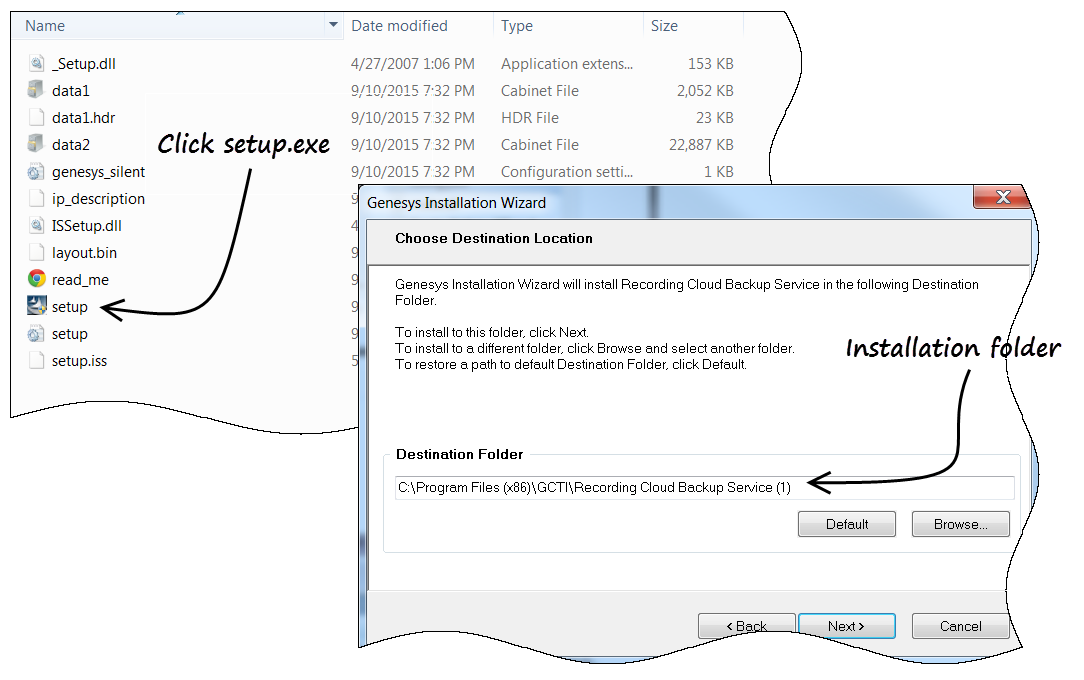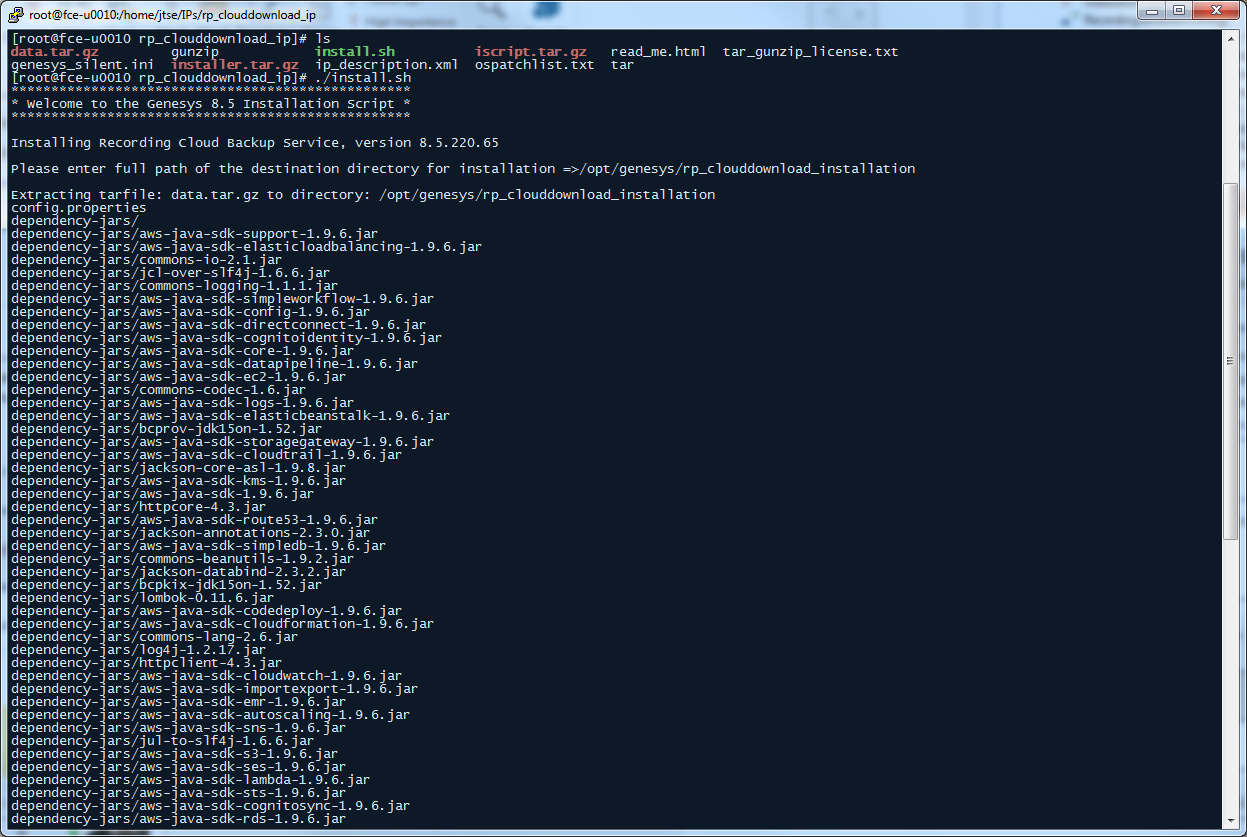Recording Cloud Backup Service
The Recording Cloud Backup Service (RCBS) allows you to make a backup copy of your Genesys Interaction Recording voice and/or screen recording files prior to their automated deletion as per the Cloud retention policy. Once installed, you can securely download the encrypted voice and screen recording files from Amazon S3 and their respective metadata files from PureEngage and store them on your local machines. The recording file can then be decrypted and used as desired, for example, for compliance.
Important
- Unless backed up, all recordings will be deleted when maximum retention date is reached.
- RCBS will only work with encrypted recordings. Therefore, ensure encryption is enabled.
- RCBS does not support MPLS.
Prerequisites
Before you can install and use the Recording Cloud Backup Service on your desktop, verify that you have the following prerequisites. Your IT department or your Genesys professional can help you get this information.
- Windows Server 2008/2012 64-bit or Red Hat Enterprise Linux AS 6 Operating System with admin privileges.
- 4 GB RAM, minimum 20 GB hard drive (the amount of space required depends on the number of recordings to be downloaded).
- The Recording Cloud Backup Service software (minimum version 8.5.2xx.xx).
- The target directory or shared folder in your environment to download the recording files to—for example, C:/target_directory (this is for the targetDir parameter).
- The private key you used to initially configure recording file encryption, so that the recording files can be decrypted (this is for decrypting the downloaded files).
- The name of your Platform Administration tenant administrator account – (this is for the GWS_USERNAME environment variable). Usernames should be in the format username@customer_tenant.com.
- The password for your Platform Administration tenant administrator account – (this is for the GWS_PASSWORD environment variable).
- The path to your Java installation directory (for example, /usr/java/jre1.7.0_79) (this is for the JAVA_HOME environment variable). Java 7 is the current supported version.
Security
The recording files are encrypted throughout the media lifecycle. After the recording files are created, they are encrypted and stored in Amazon S3. RCBS securely transfers the encrypted recordings from S3 to your local machine by using the HTTPS internet protocol. The recordings can be decrypted only on your local machine.
Getting Started
The following sections explain how to request RCBS functionality and install the software on Windows and Linux environments.
Requesting RCBS functionality
To request RCBS functionality, create a Salesforce case to request delivery of the software. Customer Care will provide an FTP download link to the software, and they will be in touch to request:
- The public IP ranges for the network where the RCBS client software will be installed and from where access to recordings will be established.
- A public PGP key so the Genesys Operations team can securely transfer the S3 storage access credentials to you, which are needed by the RCBS to access the recording storage location.
Once the software has been delivered, Genesys will provide you with the following information:
- The Interaction Recording Web Services URL to access the recording metadata—for example, https://example.com/api/v2 (this is for the gwsUriPrefix parameter).
- The access ID for the S3 storage, used to gain access to the recordings – (this is for the AWS_ACCESS_KEY_ID environment variable).
- The secret access key for the S3 storage, used to gain access to the recordings – (this is for the AWS_SECRET_ACCESS_KEY environment variable).
Installing on Windows
Locate your software in the installation directory, and click setup.exe to start the Genesys Installation Wizard.
Follow through the wizard until finished making sure that you make note of the installation directory.
Check the installation directory and verify that the config.properties file is available.
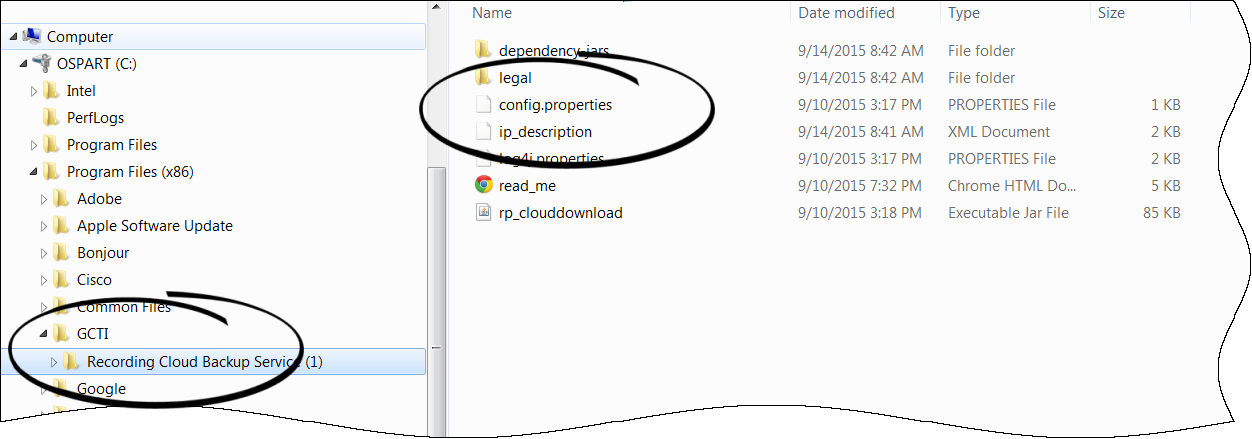
Installing on Linux
The glibc.i686 package is required to install RCBS. To install glibc.i686, run the following command: yum install glibc.i686
In the installation directory, at the prompt, type ./install.sh.
Let the script install your software.
Check the installation directory and verify that the config.properties file is available.
Configuration and Setup
The following sections explain the configuration properties and environment variables to set for proper functioning of RCBS.
Configuration Properties
The following properties must be modified to successfully retrieve recording files from Amazon S3. Locate your config.properties file, usually found in the installation directory, edit the file with a text editor, and set the following parameters:
| Parameter Name
|
Description
|
Example Value
|
| gwsUriPrefix
|
The URL prefix of Interaction Recording Web Services where the metadata for the recording files is retrieved from. This is a mandatory parameter and will be provided by Genesys.
|
https://example.com/api/v2
|
| maxAge
|
All recordings newer than the specified maxAge value, in days, are downloaded. You can specify any integer greater than or equal to 0 (0 is any age). The default value is 2, which means that all recordings from the last 2 days will be retrieved. If recordings have already been downloaded, they will not be downloaded again.
Note: If recordings are moved from their downloaded folder (targetDir), they will be downloaded again when RCBS is run. To ensure recordings are not downloaded more than once, only move recordings from this folder once maxAge days have passed since RCBS was last run.
|
2
|
| targetDir
|
The directory where the recordings are downloaded to. This directory can be anywhere on the system as long as the account running the software has permission to write to the directory.
Note:
- On both Windows and Linux, you must use the directory separator "/" (forward slash) instead of "\" (backslash).
- RCBS supports the use of a UNC path for targetDir. For example, targetDir = //server_name/path.
|
<Installation Directory>/target
|
Specify the following parameters only if the machine running RCBS cannot connect directly to Amazon S3 or the Interaction Recording Web Services address.
| Parameter Name
|
Description
|
Example Value
|
| awsProxyHost
|
Indicates the proxy host address to be used for Amazon Web Services. Specify only the host name or IP address.
|
10.0.1.31
|
| awsProxyPort
|
Indicates the proxy port to be used for the corresponding awsProxyHost parameter to connect to Amazon Web Services.
|
8080
|
| gwsProxyHost
|
Indicates the proxy host address to be used for Interaction Recording Web Services. The format is http://proxyaddress.
|
http://10.0.1.31
|
| gwsProxyPort
|
Indicates the proxy port to be used for the corresponding gwsProxyHost parameter to connect to Interaction Recording Web Services.
|
8080
|
Environment Variables
Once configured, before running the Recording Cloud Backup Service from the command line, the following environment variables must be set based on those provided earlier:
- GWS_USERNAME
- GWS_PASSWORD
- AWS_ACCESS_KEY_ID
- AWS_SECRET_ACCESS_KEY
Launching the Recording Cloud Backup Service
After the config.properties file has been modified and the environment variables are set, access the RCBS installation directory and type the following command line to start RCBS:
java –jar rp_clouddownload.jar –config config.properties
Important
Do not copy and paste the command from this document. Instead, manually type the command.
Once RCBS is complete, the status of the downloaded files is displayed as shown in the following image.
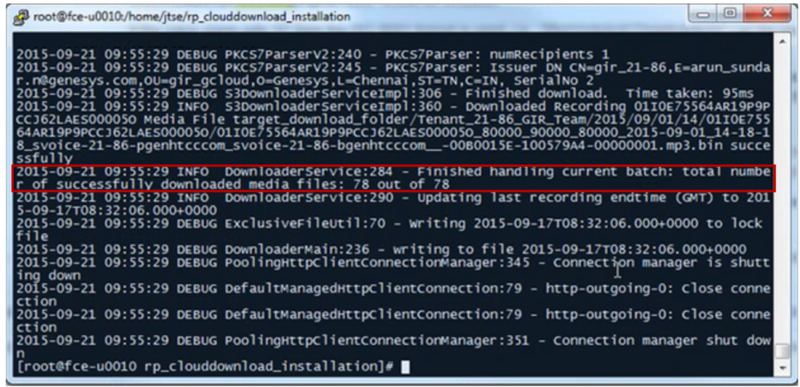
The tool exits when the backup is complete. Check your targetDir to ensure that the expected recordings have been downloaded.
The recording files are organized by date. In the below example, the target_download_folder/Tenant_21-86_GIR_Team/2015/09/ is followed by folders with a variety of dates.
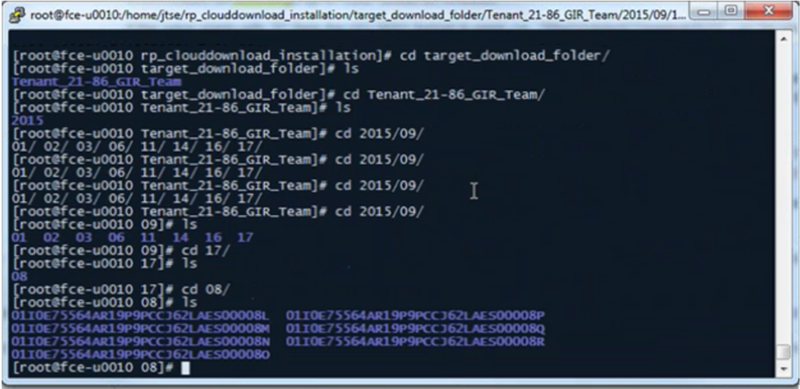
Scheduling backup
The following sections explain how to schedule a backup.
How to schedule a Windows task
For information on how to schedule or manage your tasks in Windows, see the
Windows documentation. Do not forget to set your environment variables.
How to create a Linux cronjob
You can set up a recurring backup by using cronjob (crontab -e). The following example illustrates how to use "crontab -e" to configure an appropriate cronjob on Linux:
AWS_ACCESS_KEY_ID=<access_id>
AWS_SECRET_ACCESS_KEY=<access_key>
GWS_PASSWORD=<gws_password>
GWS_USERNAME=<gws_username>
30 4,10,16,22 * * * (cd <installation_folder>; java -jar rp_clouddownload.jar -config config.properties)
Replace the above <access_id>, <access_key>, <gws_password>, <gws_username>, <installation_folder> with the actual values, and the job will be executed 4 times daily at 4:30, 10:30, 16:30 and 22:30.
Important
- Genesys strongly recommends that you create backup copies several weeks prior to the expected deletion date.
- Ensure your local machine has enough space for the scheduled backup.
Decrypting the downloaded files
You will use OpenSSL to decrypt your recording files. You can download the software by following the instructions
here.
When working with Windows, the OpenSSL binaries can be downloaded from:
OpenSSL Binaries Distribution.
To decrypt the downloaded files that are in encrypted format, use the following OpenSSL commands:
Windows:
openssl smime -decrypt –inform DER -in <encrypted.file.der> -inkey <private_key_file> –out <outputfile>
Linux:
openssl cms –decrypt –inform DER -in <encrypted.file.bin> -binary -inkey <private_key_file> –out <outputfile>
where:
<encrypted.file.der> or <encrypted.file.bin> is the file to be decrypted
<private_key_file> is the private key file
<outputfile> is the file that would be written after decryption
Each recording folder contains the encrypted recording files and the respective recording metadata files (in json format).
Storage
Ensure that the required space is available to download the desired number of recordings. Genesys recommends that you decrypt the recording files to a different destination than the encrypted files so that the original encrypted source file is not modified or overwritten by the decrypted file.
Advanced configuration
If you are an advanced user, you can change the behavior of the Recording Cloud Backup Service by changing the values of the parameters in the config.properties file.
[+] Show advanced parameters.
| Parameter Name
|
Description
|
Example Value
|
| downloadMode
|
Determines if RCBS is run in multithreaded mode and indicates whether recordings are downloaded in a serial or parallel manner. The default value is multithread (that is, enabled). This parameter is optional. If this parameter is set to single, RCBS will run in single-threaded mode.
|
multithread
|
| encryptionFormat
|
The cipher to use if the encryption is performed by the download tool. The supported values are AES-128 or AES-256. The default value is AES-128.
Note: If AES-256 is used, the JCE unlimited Strength Jurisdiction Policy File must be installed.
|
AES-128
|
| gwsRecordingsUri
|
The path to the recording API. Do not change the path from the default setting unless instructed to by Genesys. This parameter is optional.
|
/recordings
|
| gwsSettingsUri
|
The path to the settings API. Do not change the path from the default setting unless instructed to by Genesys. This parameter is optional.
|
/me/settings/rcbs
|
| mediaTypePattern
|
Indicates the file types that will be downloaded by RCBS in a regular expression. To only download MP3, set this value to audio\/mp3. This parameter is optional. The default value is audio\/mp3|video\/mp4. This value will download both audio and video files.
|
audio\/mp3|video\/mp4
|
| metadataOnly
|
Indicates whether to download the recording files along with the metadata. If set to true, the metadata is downloaded without the recordings. You do not need S3 credentials when using this option. Default value is false.
|
false
|
| minAge
|
All recordings older than the specified minAge value, in days, are downloaded. You can specify any integer greater than or equal to 0 (0 is any age). The default is 0, which means that all of the latest recordings are retrieved.
If the value starts with P, the ISO 8601 format is used—for example, P[n]Y[n]M[n]DT[n]H[n]M[n]S can be used to specify the number of days/hours/minutes/etc. If you specify a minimum age of PT30M, all recordings that are older than a half hour ago are included in processing. If you specify a minimum age of P30D, all recordings older than 30 days are included in processing. The minAge value must be less than the maxAge value.
Note: This parameter is not required, and if you set it to 0, you will always get the latest up-to-date recordings. Use this parameter with caution to avoid missing recording files.
|
0
|
| minDate
|
The absolute date, in the YYYY-MM-DD format (in GMT), to retrieve the recordings from. When specified, this value would be used as the minAge. Alternatively, the epoch time value can be specified instead of the YYYY-MM-DD format. This parameter is optional.
Note:For a one-time download of past recordings, you need to express the combination of minAge and maxAge parameters as a date range relative to now. For example,
minAge = P7DT1H
maxAge = P7DT3H
As a result, you will receive recordings from within a range of 7 days from 1 hour ago up to 7 days 3 hours ago.
The format of this string is an ISO8601 time duration string that can be set to the exact minute. To do a one-time download, we recommend that you create a copy of the config.properties file to make the changes to minAge and maxAge. When you execute RCBS, the copy of the configuration (for example, new_config.properties), will use the following command: java -jar rp_clouddownload.jar -config new_config.properties.
|
2015-07-31 Or 1438300800000
|
| maxDate
|
The absolute date, in the YYYY-MM-DD format (in GMT), to retrieve the recordings from. When specified, this value would be used as the maxAge, and override the local storage's last recording endtime's value (last_recording_endtime.txt). Alternatively, the epoch time value can be specified instead of the YYYY-MM-DD format. This parameter is optional.
|
2015-07-31 Or 1438300800000
|
| numThreads
|
Indicates the number of threads in RCBS that handle the post-processing of media files. This parameter is optional.
numThreads is only used when downloadMode is set to multithread.
|
4
|
| overlap
|
The amount of time, in hours, before the maxAge value to be re-scanned on subsequent batch downloads. This is used to help catch delayed media files that are added to interaction records after the previous run of the RCBS. The default value is 6.
If the value starts with P, the ISO 8601 format is used—for example, P[n]Y[n]M[n]DT[n]H[n]M[n]S can be used to specify the number of days/hours/minutes/etc. If you specify an overlap of P6D, all recordings from the last six days are re-scanned.
|
6
|
| rcbsInstanceId
|
When multiple instances of RCBS are deployed, rcbsInstanceId represents the current RCBS instance ID that shares the overall load. rcbsInstanceId starts at 0, up to totalRcbsInstances - 1. For example, if the download load was distributed across 4 instances of a running RCBS process, then totalRcbsInstances should be set to 4. For each RCBS's configuration, assign rcbsInstanceId 0 for the first RCBS instance, rcbsInstanceId 1 for the second RCBS instance, rcbsInstanceId 2 for the third RCBS instance, and rcbsInstanceId 3 for the fourth RCBS instance. All RCBS instances should have the same minAge and maxAge configuration. This parameter is optional.
|
0
|
| totalRcbsInstances
|
The total number of RCBS instances deployed; that is, the number of instances of RCBS that will be deployed to share the downloaded recordings in the same period. This parameter must be used with the rcbsInstanceId configuration parameter. This parameter is optional.
Note: If running multiple instances of RCBS on the same machine, each RCBS must be started from a different installation directory, and targetDir for each instance must point to a different output folder. RBCS has a built-in protection mechanism to prevent multiple instances from writing to the same directory; the second instance will terminate immediately if they share the same path.
|
4
|
| recordingFolderFormat
|
The directory structure for storing the recordings. Default value is in the yyyy/MM/dd/HH format which means the top level folder is year, subfolder is month, then date, then hour. Note the directory separator "/" (forward slash) must be used instead of "\" (backslash) on both Windows and Linux.
|
yyyy/MM/dd/HH
|
| shardBy
|
Controls the length of time (in days), within which the RCBS delivers the query to the Recording API. The default value is 1 day. For example, if the minAge and maxAge is 10 days and the shardBy value is 1 day, RCBS will download the recording and metadata one day at a time.
If the minAge and maxAge value is smaller than the shardBy value, the shardBy value will be ignored.
Note: shardBy is only relevant to version 8.5.241.13 or later.
|
1
|
| skipLastRecordingCheck
|
Indicates whether to check for the last completed download time. If set to true, the last_recording_endtime.txt is not processed, and the maxAge takes effect. Default is false. By default, the last_recording_endtime.txt file is written after each download has completed successfully. The next time when the download tool starts, it checks to see if the last_recording_endtime.txt file is older than the specified maxAge parameter. If it is, the tool uses the value from the last_recording_endtime.txt instead of the configured maxAge value.
For example, the download tool is scheduled to run daily with maxAge set to 2 days. If the server was offline for three days, it is replaced with the last_recording_endtime.txt file check, and the tool downloads all the recordings that were missed. This parameter is used to disable this recovery behavior.
|
false
|
| usePayloadSigning
|
Configures whether payload signing is used during the file transfer from Amazon S3. Disabling payload signing improves performance. To enable, set to true. Set to false (the default) to disable.
|
false
|
Recording metadata
Metadata is organized by records and can be used for finding specific calls from a larger downloaded group of recordings (for example, by searching for a particular string of text, perhaps the ‘callerPhoneNumber’). A record represents a single call interaction which may contain multiple calls and recording segments. A metadata record is uniquely identified (per switch) by a CallUUID (GUID).
The metadata record is stored in JSON format and contains three main sections within the top level object.
- The interaction level attributes (the top level object's attributes)
- The mediaFiles list—A list of media files connected to the call interaction
- The eventHistory list—A list of call events including attached data events and agent left and join events.
[+] Show the properties and examples
Metadata properties
| Property
|
Description
|
| Id
|
The CallUUID for the recording interaction.
|
| callRecordingId
|
The call recording identifier. This attribute is in screen recording metadata only.
|
| callerPhoneNumber
|
The caller's phone number.
|
| dialedPhoneNumber
|
The dialed phone number.
|
| startTime
|
The start time of the call.
|
| stopTime
|
The end time of the call.
|
| screenRecording
|
Indicates whether or not the call recording has one or more associated screen recordings. This attribute is in call recording metadata only.
|
| region
|
The region of the call.
|
| mediaFiles
|
A list of media file records. See the mediaFile properties.
|
| eventHistory
|
The events attached to the call. See the eventHistory properties.
|
mediaFile properties
The following table describes the mediaFile properties.
| Property
|
Data Type
|
Description
|
Required
|
| startTime
|
datetime
|
Specifies the start time of the media file.
|
Yes
|
| stopTime
|
datetime
|
Specifies the stop time of the media file. If MCP fails, this value will be the same as the startTime.
|
Yes
|
| mediaID
|
string
|
Specifies the media file name for the media file that is used by clients to refer to the same media file. MCP ensures that this value is globally unique.
|
Yes
|
| type
|
string
|
Specifies the MIME type of the media file.
|
Yes
|
| duration
|
time
|
Specifies the time duration of the media file.
|
No
|
| size
|
number
|
Specifies the size, in bytes, of the media file.
|
No
|
| tenant
|
string
|
Specifies the tenant that the recording belongs to.
|
Yes
|
| ivrprofile
|
string
|
Specifies the IVR Profile name that serviced the recording.
|
Yes
|
| parameters
|
object—The properties are parameters.
|
Specifies the list of additional metadata information provided by SIP Server and the client applications. The properties are:
- username
- sipsAppName
- ani
- dnis
- dateTime
- connid
- agentId
- id
- record
|
Yes
|
| masks
|
array of objects—Each object contains the time and type property.
|
Specifies the time stamps of the pause/resume periods if the recording is
masked by a client application.
|
No
|
| certAlias
|
array of strings
|
Specifies a list of aliases to the encryption certificates if the media file is encrypted.
|
No
|
| partitions
|
array of strings
|
Specifies a list of partition names for the media file.
|
Yes
|
| accessgroups
|
array of strings
|
Specifies the access groups identified agent associated with the recording.
|
Yes
|
| channels
|
number
|
Specifies whether the recording audio is capture in mono (1) or stereo (2).
|
Yes
|
eventHistory properties
The following table describes the eventHistory properties.
| Property
|
Data Type
|
Description
|
Required
|
| occurredAt
|
datetime
|
Specifies the start time of the event.
|
Yes
|
| calluuid
|
string
|
Specifies the call UUID that the event belongs to.
|
Yes
|
| event
|
string
|
Specifies the event type:
|
Yes
|
| contact
|
object
|
Specifies the the contact information of the caller who joined or left the recording if the event is Joined or Left.
|
No
|
| data
|
object
|
The attached data included in the recording if the event is data.
|
No
|
Metadata format
The following code snippet illustrates the metadata format:
{
"id" : "011AP643CSAPR4FKQGQE31TAES0001TH",
"callerPhoneNumber" : "8522001",
"dialedPhoneNumber" : "+14160000001",
"startTime" : "2015-09-01T16:42:59.000+0000",
"stopTime" : "2015-09-01T16:43:36.000+0000",
"mediaFiles" : [ {
"startTime" : "2015-09-01T16:42:59.000+0000",
"stopTime" : "2015-09-01T16:43:10.000+0000",
"callUUID" : "011AP643CSAPR4FKQGQE31TAES0001TH",
"mediaId" : "011AP643CSAPR4FKQGQE31TAES0001TH_2015-09-01_16-42-58-006B015E-10003E55-00000001.mp3",
"type" : "audio/mp3",
"duration" : "11595",
"tenant" : "Environment",
"ivrprofile" : "CallRecProfile",
"size" : "184896",
"parameters" : {
"id" : "011AP643CSAPR4FKQGQE31TAES0001TH_2015-09-01_16-42-58",
"dnis" : "+14160000001",
"username" : "screen1@genesys.com",
"connId" : "006a0269722cd7b1",
"callUuid" : "011AP643CSAPR4FKQGQE31TAES0001TH",
"ani" : "8522001",
"dateTime" : "2015-09-01T16:42:58Z",
"recordDN" : "+14160000001",
"agentId" : "+14160000001",
"sipsAppName" : "SIP_Server"
},
"certAlias" : [ "rcs_Tenant_21-86_GIR_Team:214:CN=gir_21-86,
E=arun_sundar.n@genesys.com,OU=gir_gcloud,O=Genesys,
L=Chennai,ST=TN,C=IN:2" ],
"partitions" : [ ],
"accessgroups" : [ "/" ],
"channels" : 2
}, {
"startTime" : "2015-09-01T16:43:11.000+0000",
"stopTime" : "2015-09-01T16:43:36.000+0000",
"callUUID" : "011AP643CSAPR4FKQGQE31TAES0001TH",
"mediaId" : "011AP643CSAPR4FKQGQE31TAES0001TH_2015-09-01_16-43-11-006B015E-10003E57-00000001.mp3",
"type" : "audio/mp3",
"duration" : "25426",
"tenant" : "Environment",
"ivrprofile" : "CallRecProfile",
"size" : "406080",
"parameters" : {
"id" : "011AP643CSAPR4FKQGQE31TAES0001TH_2015-09-01_16-43-11",
"dnis" : "+14160000001",
"username" : "screen3@genesys.com",
"connId" : "006a0269722cd7b1",
"callUuid" : "011AP643CSAPR4FKQGQE31TAES0001TH",
"ani" : "8522001",
"dateTime" : "2015-09-01T16:43:11Z",
"agentId" : "+14160000003",
"recordDN" : "+14160000003",
"sipsAppName" : "SIP_Server"
},
"certAlias" : [ "rcs_Tenant_21-86_GIR_Team:214:CN=gir_21-86,
E=arun_sundar.n@genesys.com,OU=gir_gcloud,O=Genesys,
L=Chennai,ST=TN,C=IN:2" ],
"partitions" : [ ],
"accessgroups" : [ "/" ],
"channels" : 2
} ],
"eventHistory" : [ {
"occurredAt" : "2015-09-01T16:42:59.000+0000",
"eventId" : "2015-09-01 16:42:59.167_011AP643CSAPR4FKQGQE31TAES0001TH",
"event" : "Data",
"calluuid" : "011AP643CSAPR4FKQGQE31TAES0001TH",
"data" : {
"added" : {
"GSIP_RECORD" : "ON",
"GSIP_REC_FN" : "011AP643CSAPR4FKQGQE31TAES0001TH_2015-09-01_16-42-58"
}
}
}, {
"occurredAt" : "2015-09-01T16:43:10.000+0000",
"eventId" : "2015-09-01 16:43:10.513_011AP643CSAPR4FKQGQE31TAES0001TH",
"event" : "Data",
"calluuid" : "011AP643CSAPR4FKQGQE31TAES0001TH",
"data" : {
"deleted" : {
"GSIP_RECORD" : "ON"
}
}
}, {
"occurredAt" : "2015-09-01T16:43:11.000+0000",
"eventId" : "2015-09-01 16:43:11.357_011AP643CSAPR4FKQGQE31TAES0001TH",
"event" : "Data",
"calluuid" : "011AP643CSAPR4FKQGQE31TAES0001TH",
"data" : {
"added" : {
"GSIP_RECORD" : "ON"
},
"updated" : {
"GSIP_REC_FN" : "011AP643CSAPR4FKQGQE31TAES0001TH_2015-09-01_16-43-11"
}
}
}, {
"occurredAt" : "2015-09-01T16:43:36.000+0000",
"eventId" : "2015-09-01 16:43:36.653_011AP643CSAPR4FKQGQE31TAES0001TH",
"event" : "Data",
"calluuid" : "011AP643CSAPR4FKQGQE31TAES0001TH",
"data" : {
"deleted" : {
"GSIP_RECORD" : "ON"
}
}
}, {
"occurredAt" : "2015-09-01T16:42:58.000+0000",
"event" : "Joined",
"calluuid" : "011AP643CSAPR4FKQGQE31TAES0001TH",
"contact" : {
"type" : "User",
"phoneNumber" : "+14160000001",
"userName" : "screen1@genesys.com",
"firstName" : "Screen",
"lastName" : "GIR"
}
}, {
"occurredAt" : "2015-09-01T16:43:11.000+0000",
"event" : "Joined",
"calluuid" : "011AP643CSAPR4FKQGQE31TAES0001TH",
"contact" : {
"type" : "User",
"phoneNumber" : "+14160000003",
"userName" : "screen3@genesys.com",
"firstName" : "Screen3",
"lastName" : "GIR"
}
}, {
"occurredAt" : "2015-09-01T16:42:58.000+0000",
"event" : "Joined",
"calluuid" : "011AP643CSAPR4FKQGQE31TAES0001TH",
"contact" : {
"type" : "External",
"phoneNumber" : "8522001"
}
}, {
"occurredAt" : "2015-09-01T16:43:10.000+0000",
"event" : "Left",
"calluuid" : "011AP643CSAPR4FKQGQE31TAES0001TH",
"contact" : {
"type" : "User",
"phoneNumber" : "+14160000001",
"userName" : "screen1@genesys.com",
"firstName" : "Screen",
"lastName" : "GIR"
}
}, {
"occurredAt" : "2015-09-01T16:43:36.000+0000",
"event" : "Left",
"calluuid" : "011AP643CSAPR4FKQGQE31TAES0001TH",
"contact" : {
"type" : "User",
"phoneNumber" : "+14160000003",
"userName" : "screen3@genesys.com",
"firstName" : "Screen3",
"lastName" : "GIR"
}
}, {
"occurredAt" : "2015-09-01T16:43:36.000+0000",
"event" : "Left",
"calluuid" : "011AP643CSAPR4FKQGQE31TAES0001TH",
"contact" : {
"type" : "External",
"phoneNumber" : "8522001"
}
} ],
"callType" : "Inbound",
"screenRecording" : false,
"region" : "region1"
}

